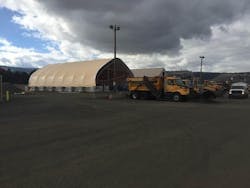“Winter isn’t over til it’s summer.”
That’s the story heard from winter maintenance workers out on the roads in the Cascade Mountains in Oregon, as the mountain range sees snowfall from as early as September to as late as May. It is in this region that most of the snowplows in the state of Oregon live, as winter crews in the mountains are hard at work for far longer than those in the rest of the state.
Being in a state with such significantly varying weather patterns, the Oregon Department of Transportation (ODOT) has some unique challenges when it comes to snow and ice control for certain regions.
One of nine new salt sheds, this one in eastern Oregon, as ODOT plans to use salt statewide for the first time.
Overall, the state of Oregon does not get to see an abundance of snowfall in the way other states do in a given year, as the state averages 15 in. of annual snowfall, according to Sperling’s Best Places. “The state DOT has fewer snowplows in the state than Minneapolis has for the city,” Dave Thompson, public affairs program manager at ODOT, told Roads & Bridges. He estimated that ODOT only carries around 250 snowplows for the whole state. “What that means sometimes, is that when we do get hit by a particularly nasty weather pattern with lots of snow, it will take us longer to dig out because we have fewer plows to do it.”
While the mountainous regions of Oregon are usually buried in snow for most of the year, areas west of the Cascade Mountain Range will not see much snow at all, such as the city of Portland, which averages 3 in. per year. However, cities east of the mountains are more likely to experience more blowing snow and icier roads. The Hood River area along I-84 near the mountain range sees 27 in. of snow annually. Coming from the Idaho border and moving west, I-84 sees much icier conditions for the first 200 miles during the colder months, as the region experiences substantial humidity and freezing fog. These conditions make it more burdensome for ODOT winter maintenance workers treating the roads after snowstorms, as new ice tends to form quickly on the road surface even after plowing and deicing. “It’s an interesting weather pattern to fight,” Thompson said. “We can be out there all day with our deicing equipment, and it’s still icy moments after we leave—that reforming ice is a constant battle.”
As of last winter, ODOT began implementing a winter maintenance practice it has traditionally avoided—laying down salt to deice the roads. In the past, the department would apply a magnesium chloride liquid deicer to treat the roads, until more severe winter conditions pushed ODOT to switch to solid salt. According to Thompson, areas of the state experienced below-freezing temperatures for 10 days in a row in the aftermath of a few snowstorms in recent seasons. “That sounds like nothing to many other states, but here with the humidity and the fog, we get ice in those conditions,” Thompson said. “And nobody can drive on ice, so we started using salt in an as-needed manner.”
Five new tow plows incorporate a special trailer that is pulled behind the plow truck to help clear two full lanes of roadway at the same time.
For the upcoming 2017-18 winter, ODOT is planning on organizing their new winter maintenance system with building salt sheds and buying new spreading equipment, as well as refitting trucks to properly carry salt. While salt will still not be the main deicer used throughout the state, certain key corridors will see salt spread out on the pavement for motorists to drive safely through winter conditions. “We plan to use it on those first 200 miles of I-84, basically from the Idaho border up to Boardman,” Thompson said. Additionally, ODOT will apply salt to the 100 miles going north on I-5 from California, as it becomes a monstrous task for trucks to climb some major hills on the route in icier conditions.
ODOT also will be introducing their fleet to some new winter maintenance tools in far eastern Oregon, including five tow plows and five dual-wing plows. Slated for use on I-84 snow-control work, the tow plows carry a special trailer pulled behind the plow truck in order to clear two full lanes on a roadway simultaneously. The trailer is equipped with a 26-ft retractable plow blade and turning wheels that can swing the unit into the travel lane on the right side of the truck. The recently configured dual-wing plows, to be used along multi-lane freeways in eastern Oregon, feature 10-ft plow blades on both sides of the truck combined with a front plow to allow two freeway lanes to be cleared in one pass.
The new equipment additions and the use of salt for deicing treatments are just a few of the ways that ODOT is gearing up to combat the sporadic winter conditions throughout the state of Oregon. “You can’t beat Mother Nature while she’s raging,” Thompson said. “You can only fight the holding battle to try to make it as quick as possible to get back to good road conditions after the storm.”


